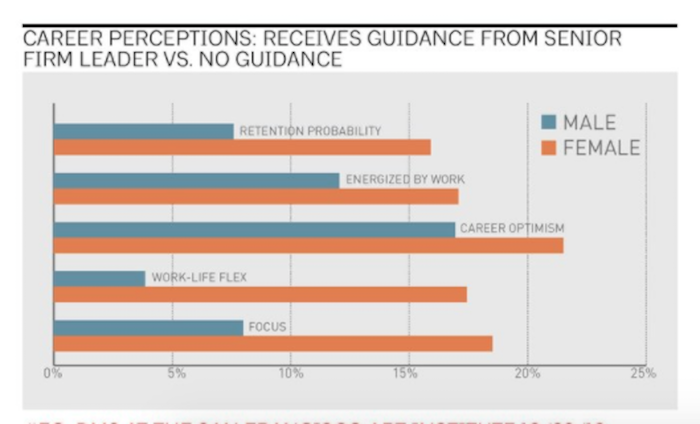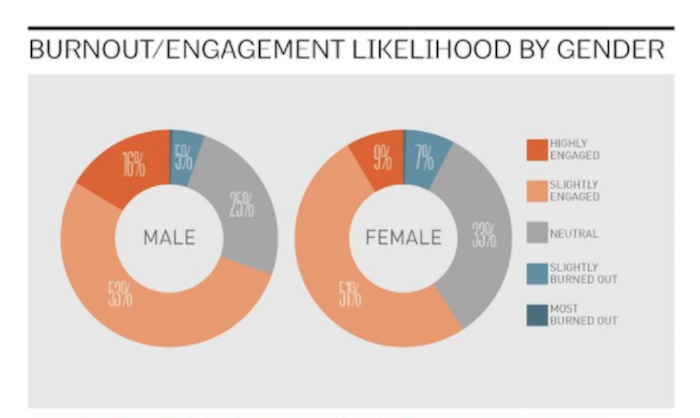A new “Equity in Architecture” survey finds that women and people of color continue to lag white men at architecture firms in career success measures such are salaries and advancement. This “achievement gap,” according to this survey, is less the result of systemic racism or sexism (although both still play in the background, like elevator music, at many firms), and more due to the lack of transparency in a firm’s process of promotions, equal access to its senior leaders, ongoing performance feedback, and having meaningful relationships at work.
The survey, conducted by the Equity by Design committee of AIA San Francisco, is based on responses to more than 80 questions from 8,664 graduates of architecture schools who are either working for an architecture firm, have worked for a firm but currently are employed in another profession, or have worked for a firm but are taking a career break or leave of absence.
The vast majority of respondents, nearly 7,000, are white males or females. And 6,600 respondents currently work at an architecture firm.
Nearly 80% of respondents said they shared their companies’ values, and 60% are engaged in decision-making and “find my work meaningful.” However, a deeper dive into the responses finds that in virtually every metric of success—including autonomy, compensation, confidence, meaningful work, focus, and work-life balance—men are more positive about their situations than women are.

The survey finds that female architects who are encouraged by a firm's senior leaders are more likely to stay with that job, and feel better about it, than men archtects. Image: Atelier Cho Thompson, courtesy of AIA San Francisco Equity in Design Committee.
One reasons might be that men are better prepared than women to take on new roles, based on their perceived respective access to a firm’s partner, principal or direct manager for professional guidance. Mentoring is critical to retention, and when women receive guidance from one of their firm’s senior leaders, they are more likely than men to stay at their jobs, be energized by their work, and be optimistic about their careers. Career guidance also has a positive effect on women architects’ attitudes about work-life balance and “focus.”
One-fifth of the survey’s respondents said that the top reason why they left their last job was low pay. And the survey finds ongoing disparities in the salaries being paid men versus women. For example, the average salary for male respondents with eight to 10 years’ experience was around $75,000, versus around $70,000 for women with the same tenure. The salary gap between men and women widens with experience. And a woman architect who is a parent, regardless of experience, is likely to be paid less than childless women, or men with or without children.
Annelise Pitts, a designer with Bohlin Cywinski Jackson and research chairman of Equity by Design, notes that women—who account for two-fifths of architecture school graduates—early in their careers often get shuttled into less-than-edifying tasks like office manager or office librarian. This “gender sorting,” says Pitts, gives women less of a shot at eventually being included in the firm’s strategic management decisions.
Once an architect has been with a firm for more than a decade, there is a significant jump in his or her perception about the likelihood of becoming a principal in their firm. However, more than half of all respondents said their firms’ leadership is “mostly male.” And 27% of male respondents and 32% of female respondents said their companies’ promotion process is either somewhat or very ineffective. Non-white males are the least likely employees to be made principals, the survey showed.
(While the survey only touches on workplace diversity, Pitts says that the biggest issue for the architectural industry remains “getting people of color into the pipeline in the first place.” Research also finds that even when minority employees are hired, they are more likely to leave firms sooner than white men or women.)
More than three-fifths of the respondents said they have “scheduling conflicts” that present challenges to maintaining a work-life balance. And women more than men attribute poor health, neglected duties, and relationship conflicts in their personal lived to this imbalance. “Women seem more willing to compromise their personal lives for work,” says Pitts. However, women are also more likely than men to turn down work-related travel because of conflicts with their personal lives.
 Women architects are more likely than men to sacrifice their personal lives for work, but are also more likely to feel the pressures of the job. Image: Atelier Cho Thompson, courtesy AIA San Francisco Equity in Design committee.
Women architects are more likely than men to sacrifice their personal lives for work, but are also more likely to feel the pressures of the job. Image: Atelier Cho Thompson, courtesy AIA San Francisco Equity in Design committee.
Burnout is more prevalent among women, especially those with less than five years experience. Half of the female respondents with five or fewer years on the job left their firm, compared to 42% of men with that same tenure who exited. Interestingly, more-tenured women appear to be less likely to leave their firms than experienced men.
Among the respondents, 667 men and 719 women currently work outside of an architecture practice. The vast majority works in another field, with a relatively small number—less than 10%—either being a full-time caregiver, a student, unemployed, or retired.
The solution to hiring and retention problems at architecture firms the survey exposes, says Pitts, comes down to them having policies in place that emphasize progressive and fair employee development, and enforcing those policies equitably and transparently. “Companies need to walk the walk,” she says.
Related Stories
Industry Research | Mar 3, 2022
AIA awards research grants to advance climate action
The American Institute of Architects (AIA) Upjohn Research Initiative is providing up to $30,000 to five research projects that will advance sustainability in architecture.
Industry Research | Mar 2, 2022
31 percent of telehealth visits result in a physical office visit
With little choice but to adopt virtual care options due to pandemic restrictions and interactions, telehealth adoption soared as patients sought convenience and more efficient care options.
Codes and Standards | Mar 1, 2022
Engineering Business Sentiment study finds optimism despite growing economic concerns
The ACEC Research Institute found widespread optimism among engineering firm executives in its second quarterly Engineering Business Sentiment study.
Multifamily Housing | Sep 1, 2021
Top 10 outdoor amenities at multifamily housing developments for 2021
Fire pits, lounge areas, and covered parking are the most common outdoor amenities at multifamily housing developments, according to new research from Multifamily Design+Construction.
Industry Research | Aug 19, 2021
BD+C Market Intelligence Reports
Exclusive research, data, and trends reports from the editors of Building Design+Construction.
Resiliency | Aug 19, 2021
White paper outlines cost-effective flood protection approaches for building owners
A new white paper from Walter P Moore offers an in-depth review of the flood protection process and proven approaches.
Multifamily Housing | Jul 7, 2021
Make sure to get your multifamily amenities mix right
One of the hardest decisions multifamily developers and their design teams have to make is what mix of amenities they’re going to put into each project. A lot of squiggly factors go into that decision: the type of community, the geographic market, local recreation preferences, climate/weather conditions, physical parameters, and of course the budget. The permutations are mind-boggling.
Digital Twin | May 24, 2021
Digital twin’s value propositions for the built environment, explained
Ernst & Young’s white paper makes its cases for the technology’s myriad benefits.
Industry Research | May 20, 2021
Latest ULI report forecasts robust real estate rebound
It’s going to take some time, though, for the office sector to recover
Industry Research | Apr 9, 2021
BD+C exclusive research: What building owners want from AEC firms
BD+C’s first-ever owners’ survey finds them focused on improving buildings’ performance for higher investment returns.

















